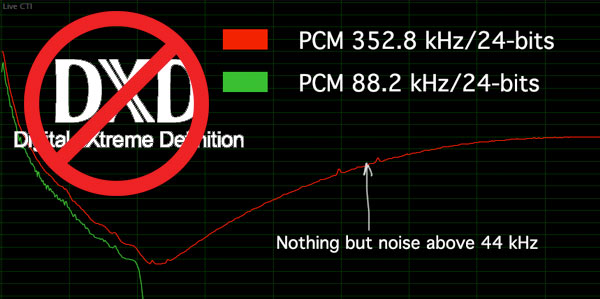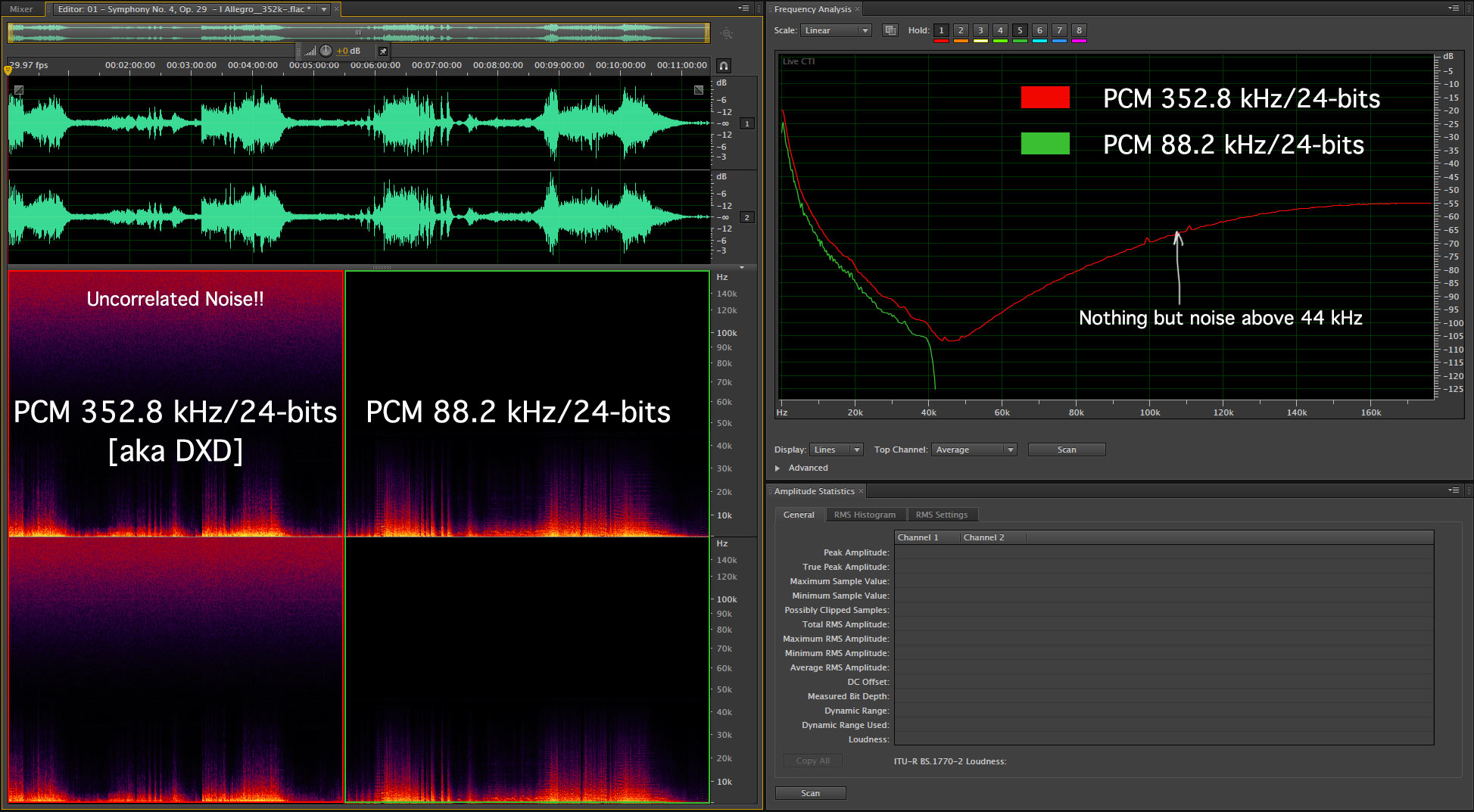Promates and High-Rate PCM (DXD) Downloads
I bit the bullet yesterday and paid almost $50 to download the DaCapo recording of the New York Philharmonic performing Carl Nielsen’s symphonies No. 1 and No. 4. The cost of the high-rate 352.8/24 bit PCM version (they market it as “DXD format”) was almost $30. I also downloaded the 88.2 kHz/24-bit PCM version for comparison. It cost me another $18.
I’ve downloaded high-rate PCM files in the past (see spectra and post here) and was surprised that the spectrogram was no better than 96 kHz/24-bit PCM. In actuality, most of the data that I downloaded (5.5 Gigs in about 90 minutes) reproduces noise or is completely empty.
The “Highest Ever Quality Digital Music Format” promoted in the Promates press release would be more accurate if they simply referred to their catalog as high-rate PCM downloads at 352.8/24-bits, which they are.
Here are the spectra of both the high-rate PCM at 352.8 kHz/24-bit and the 88.2 kHz/24-bit version. Take a look:
Figure 1 – A spectrogram of the Carl Nielsen’s Symphony No. 4 Op. 29 Movement 1 Allegro at 352.8 and 88.2 kHz PCM. [Click to enlarge]
It’s been a while since I’ve posted a spectrogram, so perhaps a little refresher explanation would be helpful. The top left of the image contains the standard amplitude vs. time layout of the stereo waveforms. This is used in DAWs to edit, fade and adjust levels. Below that is the actual spectrogram. The x-axis is time and the y-axis is frequency. The amplitude of a signal is show through color and saturation/brightness. The yellow color shows the loudest frequencies followed by orange, red and purple. If the area is black, it means there is no signal present.
On the right hand side of the image is a plot of frequency vs. amplitude. I grabbed the entire movement and scanned it for this plot. It shows the contour of the amplitude as frequency increases. A normal selection of music diminishes as you move to the higher frequencies.
The first thing to notice in the spectra is the noise that exists in the high-rate PCM or “DXD” version. Why is this? Because the converters don’t use LPFs to remove anything that eclipses the Nyquist frequency. The advocates for DXD (Merging Technologies, the company behind it) claim that they don’t need to filter the incoming signals because the noise is so high it doesn’t matter. It might not matter to our ears but equipment is not immune to ultrasonics. The “purple haze” (even red in this file) that is always present in DSD recordings is clearly present here as well. This is not musical “nuance” or “low level detail”…it’s inferior encoding plain and simple.
The 88.2 kHz/24-bit PCM is more than sufficient to capture all of the music…without the unwanted noise. Notice that the area above the signal is black. The DXD crowd likes to brag about the lack of “pre and post ringing” in high-rate PCM…but they only happen right near the Nyquest frequency. If we can’t hear the noise at these frequencies, then we can’t “hear” the pre-ringing either.
Now take a look at the top right side of the figure. The red line shows the increasing noise as the frequency moves past 45 kHz or so. The green line represents the 88.2 kHz/24-bit PCM version. It is curiously lower in volume by about 5 dB (maybe that’s why the DXD version “sounds” better…remember louder is always better). But if the levels were equalized the green and red lines would be very close to identical (In fact, they should be identical if the 88.2 is derived from the high-rate PCM version). The frequency range from 42 kHz to 140 kHz consisting of nothing but noise and empty space does absolutely nothing to increase the fidelity of the recording…as wonderful as it might sound. If you listen to the 88.2 kHz/24-bit PCM version, it will sound just as wonderful as the high-rate PCM version. And it will take a lot less time to download AND cost half as much…and you can play it on your existing hardware.
High-rate PCM at 352.8/384 kHz/24-bits might make sense for recording and post production but it makes absolutely no sense for delivering files. I’m sticking with 96 kHz/24-bit PCM for my productions. I haven’t experienced anything that sounds better so why change now.
The Promates press release is simply pitching things that aren’t true (not surprising for press notices). Many of the same recordings are available in high-resolution PCM on other sites. In fact, DaCapo has some of their recordings on the iTrax.com site at 96/24.
SO proceed with caution when people write,
“We are absolutely thrilled that a new era of customers will now be able to listen to some of our collection of albums in the highest possible audio quality. The new DXD format offers a new standard in the evolution of recorded sound. While previously only available for the fortunate few, the fact that we can offer our range of albums through Promates at great value for listeners to enjoy will transform how many will enjoy music. ‘No longer will people have to put up with inferior quality sound; DXD quality will enrich the users experience far more than they imagine with the subtle nuances of sound, inaudible at slower sample rates, now audible for the first time.'”
A paragraph of marketing spin…nothing more.
+++++++++++++++++++
I’m still looking to raise the $3700 needed to fund a booth at the 2015 International CES. I’ve received some very generous contributions but still need to raise additional funds (I’ve received about $2750 so far). Please consider contributing any amount. I write these posts everyday in the hopes that readers will benefit from my network, knowledge and experience. I hope you consider them worth a few dollars. You can get additional information at my post of December 2, 2014. Thanks.



Thanks for this. Your findings come as no surprise. There do seem to be differences on the lower (up to about 35k) part of the spectrum. Would you know why this is? Doesn’t look to me to be just the result of the 5dB difference, but then I haven’t looked at a spectrogram since the 80s.
I was wondering Mark, whether you heard a difference between the files once you level matched? Thanks for your efforts.
The 88.2 kHz/24-bit file had every bit as much “nuance” and “low level detail” as the DXD file…for half the money and a third the file size. The Promates people got the last chunk of money from me.
Excellent article. Thank you.
When we buy one piece of music for a price that we could have bought two pieces of music for, and get nothing audible in return, then the main effect of ultra-high bitrate music sales is to reduce the size of our music collections at home.
Thank you for setting the record straight!
I used to think we needed the highest resolution possible but you made it quite clear through detailed graphs (thanks for explaining how to interpret them) what is really necessary and nothing more.
I now realize 96 kHz/24-bit provides all the necessary quality as well as being essentially future-proofed in regards to higher quality playback devices.
We can now have our cake and eat it too as they say (download high quality and save a few bucks)
Great posts and VERY informative.
The point of having 352khz resolution is not to have more detail, but to have the DAC less guessing and making errors while doing so. So it is about precision in the time domain. If the “guessing errors” at 44.1khz equal 100% error, with 96khz it is only 1/2 and with 192khz 1/4. With 384khz only 1/8 of the errors would be left.
352khz = YOU GET LESS DIGITAL NOISE = more natural and relaxing sound.
I recommend to put the audio tools aside and start listening.
I beg to differ. Since when to DACs guess at the amplitude values at each sample point? They don’t. There is quantization error according to the Shannon-Nyquist Theorem but that’s not the same as guess in a DAC. Increasing the sample rate beyond that needed to correctly sample the required frequency spectrum and provide the electronics with simple filtering doesn’t result in a “more natural and relaxing sound”. Your description of the process doesn’t mesh with the facts in audio encoding. I would challenge anyone to be able to perceive a difference in fidelity between the same file at 384 kHz and 48 kHz…no one can. I do lots of listening, have been a professional audio engineer for decades and instructor of audio for almost as long. Tools are exceedingly value in assessing the potential of an audio system…we should be using our ear to validate advances in technology. Moving beyond 96 kHz has absolutely no audible sonic benefits. It does however allow manufacturers to increase their profits.